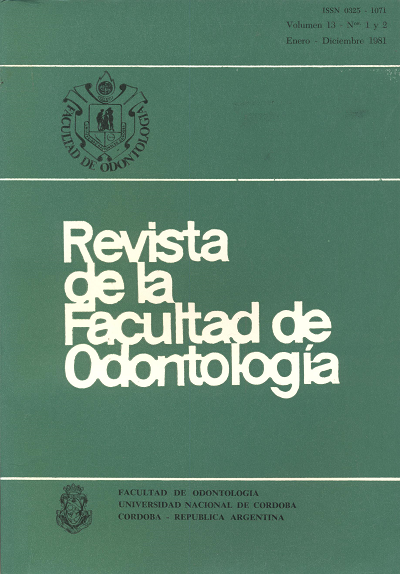Contribution to the study and treatment of lower maxillar fractures
Keywords:
Mandible, Case Studies, Mandibular Injuries, TherapeuticsAbstract
186 cases of lower maxillar fractures are stu:died and analyzed with therapeutic criterion Traffic accidents were shown fustly as an etiologic agent. The main fractures localizations were placed on maxillar angle and canine areas. Dental surgeon direct participation in the diagnosis and treatrnent is of fundamental importance: 1Q It allows to appraise the state of reJ:IW.ant dental pieces and those placed on fracture plane with their corresponding use in plan of trealment. 2Q) It allows to use odontologic instrurnents as prothesis, brackets, orthodontíc bands, autopolymerization acrylics in their synthe- sis; Elastic bands use in intermaxillar immobility allows the:r withdrawl in cases of emergency without altering heali;ng process. The most frequent involvements were: csteomyelitis, lack of consolidation due to failure in inmmobil:" ty and :léicient joint because the presence and placemeDt of .lenta! pieces were not taken as reference in their diagnosis aud treatruent
Downloads
Published
Issue
Section
License
Aquellos autores/as que tengan publicaciones con esta revista, aceptan los términos siguientes:
- Los autores/as conservarán sus derechos de autor y garantizarán a la revista el derecho de primera publicación de su obra, el cuál estará simultáneamente sujeto a la Licencia de reconocimiento de Creative Commons que permite a terceros:
- Compartir — copiar y redistribuir el material en cualquier medio o formato
- La licenciante no puede revocar estas libertades en tanto usted siga los términos de la licencia
- Los autores/as podrán adoptar otros acuerdos de licencia no exclusiva de distribución de la versión de la obra publicada (p. ej.: depositarla en un archivo telemático institucional o publicarla en un volumen monográfico) siempre que se indique la publicación inicial en esta revista.
- Se permite y recomienda a los autores/as difundir su obra a través de Internet (p. ej.: en archivos telemáticos institucionales o en su página web) después del su publicación en la revista, lo cual puede producir intercambios interesantes y aumentar las citas de la obra publicada. (Véase El efecto del acceso abierto).

